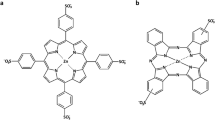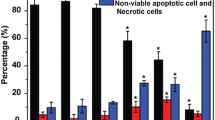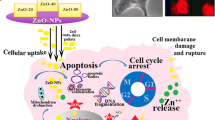Abstract
In this study, C-doped TiO2 nanoparticles (C-TiO2) were prepared and tested as a photosensitizer for visible-light-driven photodynamic therapy against cervical cancer cells (HeLa). X-ray diffraction and Transmission Electron Microscopy confirmed the anatase form of nanoparticles, spherical shape, and size distribution from 5 to 15 nm. Ultraviolet–visible light spectroscopy showed that C doping of TiO2 enhances the optical absorption in the visible light range caused by a bandgap narrowing. The photo-cytotoxic activity of C-TiO2 was investigated in vitro against HeLa cells. The lack of dark cytotoxicity indicates good biocompatibility of C-TiO2. In contrast, a combination with blue light significantly reduced the survival of HeLa cells: illumination only decreased cell viability by 30% (15 min of illumination, 120 µW power), and 60% when HeLa cells were preincubated with C-TiO2. We have also confirmed blue light-induced C-TiO2-catalyzed generation of reactive oxygen species in vitro and intracellularly. Oxidative stress triggered by C-TiO2/blue light was the leading cause of HeLa cell death. Fluorescent labeling of treated HeLa cells showed distinct morphological changes after the C-TiO2/blue light treatment. Unlike blue light illumination, which caused the appearance of large necrotic cells with deformed nuclei, cytoplasm swelling, and membrane blebbing, a combination of C-TiO2/blue light leads to controlled cell death, thus providing a better outcome of local anticancer therapy.
Graphic abstract








Similar content being viewed by others
Availability of data and material
The datasets generated during and/or analyzed during the current study are available from the corresponding author on reasonable request.
Code availability
Not applicable.
Abbreviations
- ∙OH:
-
: Hydroxyl radicals
- ANOVA:
-
: Analysis of variance
- AO:
-
Acridine orange
- ATCC:
-
American Type Culture Collection
- AVOs:
-
Acidic vesicular organelles
- CB:
-
Conduction band
- C-TiO2 :
-
Carbon-doped titanium dioxide
- DCF:
-
Dichlorofluorescein
- DCFH-DA:
-
2,7-Dichlorofluorescein diacetate
- DEPMPO:
-
5–(Diethoxyphosphoryl)–5–methyl–1–pyrroline–N–oxide
- DIC:
-
Differential interference contrast
- DMEM:
-
Dulbecco’s Modified Eagle’s Medium
- EDTA:
-
Ethylenediaminetetraacetic acid
- EPR:
-
Electron paramagnetic spectroscopy
- FBS:
-
Fetal bovine serum
- H2DCFDA:
-
2′,7′-Dichlorodihydrofluorescein diacetate
- HeLa:
-
Henrietta Lacks (in the text referred to the human epithelial cervical cancer cells)
- HRTM:
-
High-resolution transmission electron microscopy
- LSCM:
-
Laser scanning confocal microscopy
- MTT:
-
3–(4,5–Dimethylthiazol–2–yl)–2,5–diphenyl–2H–tetrazolium bromide
- NPs:
-
Nanoparticles
- PBS:
-
Phosphate-buffered saline
- PDT:
-
Photodynamic therapy
- PI:
-
Propidium iodide
- PS:
-
Photosensitizer
- RCF:
-
Relative centrifugal force
- ROS:
-
Reactive oxygen species
- SRB:
-
Sulforhodamine B
- TBHB:
-
Tert-butyl hydroperoxide
- TEM:
-
Transmission electron microscopy
- TiO2 :
-
Titanium dioxide
- UV:
-
Ultraviolet
- UV–Vis:
-
Ultraviolet–visible light
- VB:
-
Valence band
- XRPD:
-
X-ray powder diffraction
References
Abbasi, A. (2019). Chapter 7—TiO2-based nanocarriers for drug delivery. In S. S. Mohapatra, S. Ranjan, N. Dasgupta, R. K. Mishra, & S. Thomas (Eds.), Nanocarriers for Drug Delivery (pp. 205–248). Amsterdam: Elsevier.
Flak, D., Yate, L., Nowaczyk, G., & Jurga, S. (2017). Hybrid ZnPc@TiO2 nanostructures for targeted photodynamic therapy, bioimaging and doxorubicin delivery. Materials Science & Engineering, C: Materials for Biological Applications, 78, 1072–1085. https://doi.org/10.1016/j.msec.2017.04.107
Nešić, M., Žakula, J., Korićanac, L., Stepić, M., Radoičić, M., Popović, I., Šaponjić, Z., & Petković, M. (2017). Light controlled metallo-drug delivery system based on the TiO2-nanoparticles and Ru-complex. Journal of Photochemistry and Photobiology A: Chemistry., 347, 55–66. https://doi.org/10.1016/j.jphotochem.2017.06.045
Yurt, F., Ocakoglu, K., Er, O., Soylu, H. M., Ince, M., Avci, C. B., Kurt, C. C., Sarı, F. A., Colak, S. G., & Gunduz, C. (2019). Evaluation of photodynamic therapy and nuclear imaging potential of subphthalocyanine integrated TiO2 nanoparticles in mammary and cervical tumor cells. Journal of Porphyrins and Phthalocyanines, 23, 908–915. https://doi.org/10.1142/S1088424619500639
Wei, B., Dong, F., Yang, W., Luo, C., Dong, Q., Zhou, Z., Yang, Z., & Sheng, L. (2020). Synthesis of carbon-dots@SiO2@TiO2 nanoplatform for photothermal imaging induced multimodal synergistic antitumor. Journal of Advanced Research., 23, 13–23. https://doi.org/10.1016/j.jare.2020.01.011
Sakib, S., Pandey, R., Soleymani, L., & Zhitomirsky, I. (2020). Surface modification of TiO2 for photoelectrochemical DNA biosensors. Medical Devices & Sensors., 3, e10066. https://doi.org/10.1002/mds3.10066
Wang, J., Xu, G., Zhang, X., Lv, J., Zhang, X., Zheng, Z., & Wu, Y. (2015). Electrochemical performance and biosensor application of TiO2 nanotube arrays with mesoporous structures constructed by chemical etching. Dalton Transactions, 44, 7662–7672. https://doi.org/10.1039/C5DT00678C
Mavrič, T., Benčina, M., Imani, R., Junkar, I., Valant, M., Kralj-Iglič, V., & Iglič, A. (2018). Chapter three—Electrochemical biosensor based on tio2 nanomaterials for cancer diagnostics. In A. Iglič, M. Rappolt, & A. J. García-Sáez (Eds.), Advances in Biomembranes and Lipid Self-Assembly (pp. 63–105). London: Academic Press. https://doi.org/10.1016/bs.abl.2017.12.003
Shah, Z., Nazir, S., Mazhar, K., Abbasi, R., & Samokhvalov, I. M. (2019). PEGylated doped- and undoped-TiO2 nanoparticles for photodynamic Therapy of cancers. Photodiagnosis and Photodynamic Therapy., 27, 173–183. https://doi.org/10.1016/j.pdpdt.2019.05.019
Matijević, M., Nakarada, Đ, Liang, X., Korićanac, L., Rajsiglova, L., Vannucci, L., Nešić, M., Vranješ, M., Mojović, M., Mi, L., Estrela-Lopis, I., Böttner, J., Šaponjić, Z., Petković, M., & Stepić, M. (2020). Biocompatibility of TiO2 prolate nanospheroids as a potential photosenzitizer in therapy of cancer. Journal of Nanoparticle Research, 22, 175. https://doi.org/10.1007/s11051-020-04899-3
Chizenga, E. P., Chandran, R., & Abrahamse, H. (2019). Photodynamic therapy of cervical cancer by eradication of cervical cancer cells and cervical cancer stem cells. Oncotarget, 10, 4380–4396. https://doi.org/10.18632/oncotarget.27029
Muroya, T., Suehiro, Y., Umayahara, K., Akiya, T., Iwabuchi, H., Sakunaga, H., Sakamoto, M., Sugishita, T., & Tenjin, Y. (1996). Photodynamic therapy (PDT) for early cervical cancer, Gan to Kagaku ryoho. Cancer & Chemotherapy., 23, 47–56.
ESMO, Cervical Cancer Ranked in the Top Three Cancers Affecting Women Younger Than 45 Years, (n.d.). Retrieved March 10, 2021, from https://www.esmo.org/oncology-news/cervical-cancer-ranked-in-the-top-three-cancers-affecting-women-younger-than-45-years.
Kubota, Y., Shuin, T., Kawasaki, C., Hosaka, M., Kitamura, H., Cai, R., Sakai, H., Hashimoto, K., & Fujishima, A. (1994). Photokilling of T-24 human bladder cancer cells with titanium dioxide. British Journal of Cancer, 70, 1107–1111. https://doi.org/10.1038/bjc.1994.456
Zhang, A.-P., & Sun, Y.-P. (2004). Photocatalytic killing effect of TiO2 nanoparticles on Ls-174-t human colon carcinoma cells. World Journal of Gastroenterology, 10, 3191–3193. https://doi.org/10.3748/wjg.v10.i21.3191
Cai, R., Hashimoto, K., Kubota, Y., & Fujishima, A. (1992). Increment of photocatalytic killing of cancer cells using TiO2 with the aid of superoxide dismutase. Chemistry Letters, 21, 427–430. https://doi.org/10.1246/cl.1992.427
Galata, E., Georgakopoulou, E. A., Kassalia, M.-E., Papadopoulou-Fermeli, N., & Pavlatou, E. A. (2019). Development of smart composites based on doped-tio2 nanoparticles with visible light anticancer properties. Materials (Basel). https://doi.org/10.3390/ma12162589
Basavarajappa, P. S., Patil, S. B., Ganganagappa, N., Reddy, K. R., Raghu, A. V., & Reddy, Ch. V. (2020). Recent progress in metal-doped TiO2, non-metal doped/codoped TiO2 and TiO2 nanostructured hybrids for enhanced photocatalysis. International Journal of Hydrogen Energy., 45, 7764–7778. https://doi.org/10.1016/j.ijhydene.2019.07.241
Etacheri, V., Di Valentin, C., Schneider, J., Bahnemann, D., & Pillai, S. C. (2015). Visible-light activation of TiO2 photocatalysts: Advances in theory and experiments. Journal of Photochemistry and Photobiology C: Photochemistry Reviews., 25, 1–29. https://doi.org/10.1016/j.jphotochemrev.2015.08.003
Ansari, S. A., Khan, M. M., Ansari, M. O., & Cho, M. H. (2016). Nitrogen-doped titanium dioxide (N-doped TiO2) for visible light photocatalysis. New Journal of Chemistry, 40, 3000–3009. https://doi.org/10.1039/C5NJ03478G
Li, Z., Mi, L., Wang, P.-N., & Chen, J.-Y. (2011). Study on the visible-light-induced photokilling effect of nitrogen-doped TiO2 nanoparticles on cancer cells. Nanoscale Research Letters., 6, 356. https://doi.org/10.1186/1556-276X-6-356
Yang, C.-C., Wang, C.-X., Kuan, C.-Y., Chi, C.-Y., Chen, C.-Y., Lin, Y.-Y., Chen, G.-S., Hou, C.-H., & Lin, F.-H. (2020). Using C-doped TiO2 nanoparticles as a novel sonosensitizer for cancer treatment. Antioxidants (Basel). https://doi.org/10.3390/antiox9090880
Dong, F., Guo, S., Wang, H., Li, X., & Wu, Z. (2011). Enhancement of the visible light photocatalytic activity of C-Doped TiO2 nanomaterials prepared by a green synthetic approach. Journal of Physical Chemistry C, 115, 13285–13292. https://doi.org/10.1021/jp111916q
Ren, W., Ai, Z., Jia, F., Zhang, L., Fan, X., & Zou, Z. (2007). Low temperature preparation and visible light photocatalytic activity of mesoporous carbon-doped crystalline TiO2. Applied Catalysis B: Environmental., 69, 138–144. https://doi.org/10.1016/j.apcatb.2006.06.015
Vranješ, M., Kuljanin Jakovljević, J., Konstantinović, Z., Pomar, A., Stoiljković, M., Mitrić, M., Radetić, T., & Šaponjić, Z. (2017). Shaped Co2+ doped TiO2 nanocrystals synthesized from nanotubular precursor: Structure and ferromagnetic behavior. Journal of Advanced Ceramics, 6, 220–229. https://doi.org/10.1007/s40145-017-0233-5
Skehan, P., Storeng, R., Scudiero, D., Monks, A., McMahon, J., Vistica, D., Warren, J. T., Bokesch, H., Kenney, S., & Boyd, M. R. (1990). New colorimetric cytotoxicity assay for anticancer-drug screening. JNCI Journal of the National Cancer Institute, 82, 1107–1112. https://doi.org/10.1093/jnci/82.13.1107
Abdel Wahab, S. I., Abdul, A. B., Alzubairi, A. S., Mohamed Elhassan, M., & Mohan, S. (2009). In vitro ultramorphological assessment of apoptosis induced by zerumbone on (HeLa). Journal of Biomedicine and Biotechnology, 2009, 769568. https://doi.org/10.1155/2009/769568
Li, T.-H., & Yan, H.-X. (2018). Antitumor- and apoptosis-inducing effects of pomolic acid against SK-MEL-2 human malignant melanoma cells are mediated via inhibition of cell migration and sub-G1 cell cycle arrest. Molecular Medicine Reports, 17, 1035–1040. https://doi.org/10.3892/mmr.2017.7977
Jackson, S. K., Liu, K. J., Liu, M., & Timmins, G. S. (2002). Detection and removal of contaminating hydroxylamines from the spin trap DEPMPO, and re-evaluation of its use to indicate nitrone radical cation formation and S(N)1 reactions. Free Radical Biology & Medicine, 32, 228–232. https://doi.org/10.1016/s0891-5849(01)00795-x
Dubey, R. S., & Singh, S. (2017). Investigation of structural and optical properties of pure and chromium doped TiO2 nanoparticles prepared by solvothermal method. Results in Physics, 7, 1283–1288. https://doi.org/10.1016/j.rinp.2017.03.014
Singh Surah, S., Vishwakarma, M., Kumar, R., Nain, R., Sirohi, S., & Kumar, G. (2019). Tuning the electronic band alignment properties of TiO2 nanotubes by boron doping. Results in Physics, 12, 1725–1731. https://doi.org/10.1016/j.rinp.2019.01.081
Huang, F., Yan, A., & Zhao, H. (2016). Influences of doping on photocatalytic properties of TiO2 photocatalyst, semiconductor photocatalysis in materials. Mechanisms and Applications. https://doi.org/10.5772/63234
Yu, J., Dai, G., Xiang, Q., & Jaroniec, M. (2011). Fabrication and enhanced visible-light photocatalytic activity of carbon self-doped TiO2 sheets with exposed 001 facets. Journal of Materials Chemistry, 21, 1049–1057. https://doi.org/10.1039/C0JM02217A
Guo, M., & Du, J. (2013). Electronic and optical properties of C-N-codoped TiO2: A first-principles GGA+U investigation. International Journal of Modern Physics B, 27, 1350123. https://doi.org/10.1142/S0217979213501233
Zhao, C., Huang, D., & Chen, J. (2018). DFT study for combined influence of C-doping and external electric field on electronic structure and optical properties of TiO2 (001) surface. Journal of Materiomics., 4, 247–255. https://doi.org/10.1016/j.jmat.2018.05.003
Xie, J., Pan, X., Wang, M., Ma, J., Fei, Y., Wang, P.-N., & Mi, L. (2016). The role of surface modification for TiO2 nanoparticles in cancer cells. Colloids and Surfaces. B, Biointerfaces, 143, 148–155. https://doi.org/10.1016/j.colsurfb.2016.03.029
Oh, P.-S., Hwang, H., Jeong, H.-S., Kwon, J., Kim, H.-S., Kim, M., Lim, S., Sohn, M.-H., & Jeong, H.-J. (2016). Blue light emitting diode induces apoptosis in lymphoid cells by stimulating autophagy. International Journal of Biochemistry & Cell Biology, 70, 13–22. https://doi.org/10.1016/j.biocel.2015.11.004
Oh, P.-S., Na, K. S., Hwang, H., Jeong, H.-S., Lim, S., Sohn, M.-H., & Jeong, H.-J. (2015). Effect of blue light emitting diodes on melanoma cells: Involvement of apoptotic signaling. Journal of Photochemistry and Photobiology B: Biology, 142, 197–203. https://doi.org/10.1016/j.jphotobiol.2014.12.006
Yan, G., Zhang, L., Feng, C., Gong, R., Idiiatullina, E., Huang, Q., He, M., Guo, S., Yang, F., Li, Y., Ding, F., Ma, W., Pavlov, V., Han, Z., Wang, Z., Xu, C., Cai, B., Yuan, Y., & Yang, L. (2018). Blue light emitting diodes irradiation causes cell death in colorectal cancer by inducing ROS production and DNA damage. The International Journal of Biochemistry & Cell Biology., 103, 81–88. https://doi.org/10.1016/j.biocel.2018.08.006
Oh, P.-S., Kim, H.-S., Kim, E.-M., Hwang, H., Ryu, H. H., Lim, S., Sohn, M.-H., & Jeong, H.-J. (2017). Inhibitory effect of blue light emitting diode on migration and invasion of cancer cells. Journal of Cellular Physiology, 232, 3444–3453. https://doi.org/10.1002/jcp.25805
Zhuang, J., Liu, Y., Yuan, Q., Liu, J., Liu, Y., Li, H., & Wang, D. (2018). Blue light-induced apoptosis of human promyelocytic leukemia cells via the mitochondrial-mediated signaling pathway. Oncology Letters, 15, 6291–6296. https://doi.org/10.3892/ol.2018.8162
Yang, M.-Y., Chang, C.-J., & Chen, L.-Y. (2017). Blue light induced reactive oxygen species from flavin mononucleotide and flavin adenine dinucleotide on lethality of HeLa cells. Journal of Photochemistry and Photobiology B: Biology, 173, 325–332. https://doi.org/10.1016/j.jphotobiol.2017.06.014
Waer, C. N., Kaur, P., Tumur, Z., Hui, D. D., Le, B., Guerra, C., et al. (2020). Rosmarinic Acid/ Blue Light Combination Treatment Inhibits Head and Neck Squamous Cell Carcinoma In Vitro. Anticancer Res., 40, 751–758. https://doi.org/10.21873/anticanres.14006
Tuloup-Minguez, V., Greffard, A., Codogno, P., & Botti, J. (2011). Regulation of autophagy by extracellular matrix glycoproteins in HeLa cells. Autophagy, 7, 27–39. https://doi.org/10.4161/auto.7.1.13851
Fang, C., Gu, L., Smerin, D., Mao, S., & Xiong, X. (2017). The Interrelation between Reactive Oxygen Species and Autophagy in Neurological Disorders. Oxidative Medicine and Cellular Longevity., 2017, e8495160. https://doi.org/10.1155/2017/8495160
Yoboue, E. D., Sitia, R., & Simmen, T. (2018). Redox crosstalk at endoplasmic reticulum (ER) membrane contact sites (MCS) uses toxic waste to deliver messages. Cell Death & Disease, 9, 331. https://doi.org/10.1038/s41419-017-0033-4
Ullman, E., Fan, Y., Stawowczyk, M., Chen, H.-M., Yue, Z., & Zong, W.-X. (2008). Autophagy promotes necrosis in apoptosis-deficient cells in response to ER stress. Cell Death and Differentiation, 15, 422–425. https://doi.org/10.1038/sj.cdd.4402234
Z. Yu, Q. Li, J. Wang, Y. Yu, Y. Wang, Q. Zhou, P. Li. (2020). Reactive oxygen species-related nanoparticle toxicity in the biomedical field. Nanoscale Res Lett, 15. https://doi.org/10.1186/s11671-020-03344-7
Kushibiki, T., Hirasawa, T., Okawa, S., & Ishihara, M. (2013). Blue laser irradiation generates intracellular reactive oxygen species in various types of cells. Photomedicine and Laser Surgery, 31, 95–104. https://doi.org/10.1089/pho.2012.3361
He, W., Liu, Y., Wamer, W. G., & Yin, J.-J. (2014). Electron spin resonance spectroscopy for the study of nanomaterial-mediated generation of reactive oxygen species. Journal of Food and Drug Analysis., 22, 49–63. https://doi.org/10.1016/j.jfda.2014.01.004
Dvoranová, D., Barbieriková, Z., & Brezová, V. (2014). Radical Intermediates in Photo-induced Reactions on TiO2 (An EPR Spin Trapping Study). Molecules, 19, 17279–17304. https://doi.org/10.3390/molecules191117279
Krumova, K., & Cosa, G. (2016). Chapter 1, Overview of Reactive Oxygen Species 1–21. https://doi.org/10.1039/9781782622208-00001
Shi, H., Magaye, R., Castranova, V., & Zhao, J. (2013). Titanium dioxide nanoparticles: A review of current toxicological data. Particle and Fibre Toxicology, 10, 15. https://doi.org/10.1186/1743-8977-10-15
Acknowledgements
This work was supported by the Ministry of Education, Science and Technological Development of the Republic of Serbia (grant number 451-03-68/2020-14/200017, 451-03-68/2020-14/200146).
Funding
This work was supported by the Ministry of Education, Science and Technological Development of the Republic of Serbia, Serbian-Chinese bilateral project (grant number 451–00-478/2018–09/16), and by the Ministry of science and technology of the People's Republic of China (China-Serbia bilateral project SINO-SERBIA2018002).
Author information
Authors and Affiliations
Contributions
Milica Matijević: investigation, validation, methodology, formal analysis, writing—original Draft, visualization. Jelena Žakula, Lela Korićanac, Marija Radoičić, Xinyue Liang, Đura Nakarada, Jelena Filipović Tričković, and Ana Valenta Šobot: investigation, formal analysis, writing—original Draft. Maja Stanković: writing: review & editing, supervision. Miloš Mojović, Lan Mi, Marijana Petković and Milutin Stepić: resources, writing—review & editing, funding acquisition. Maja D. Nešić: conceptualization, writing—review & editing, methodology, project administration, supervision.
Corresponding author
Ethics declarations
Conflicts of interest
The authors declare that they have no known competing financial interests or personal relationships that could have appeared to influence the work reported in this paper.
Ethics approval
Not applicable.
Consent to participate
All authors consented to participate.
Consent for publication
All authors approved the version to be published.
Rights and permissions
About this article
Cite this article
Matijević, M., Žakula, J., Korićanac, L. et al. Controlled killing of human cervical cancer cells by combined action of blue light and C-doped TiO2 nanoparticles. Photochem Photobiol Sci 20, 1087–1098 (2021). https://doi.org/10.1007/s43630-021-00082-2
Received:
Accepted:
Published:
Issue Date:
DOI: https://doi.org/10.1007/s43630-021-00082-2




